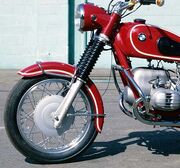
1968 BMW R60US with conventional telescopic fork
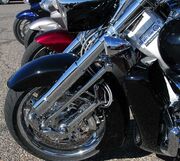
Unusual "trailing bottom link" on a Honda Rune
A motorcycle fork connects a motorcycle's front wheel and axle to its frame, typically via a pair of triple clamps. It typically incorporates the front suspension and front brake, and allows the bike to be steered via handlebars attached to the top clamp.
The fork and its attachment points on the frame establish the critical geometric parameters of rake and trail, which play a major role in defining how a motorcycle handles and dives during braking.[1]
Variations[]
| This section needs additional citations for verification. Please help improve this article by adding citations to reliable sources. Unsourced material may be challenged and removed. (July 2009) |
Over more than one hundred years of motorcycle development a variety of front fork arrangements have been tried, several of which remain available today.
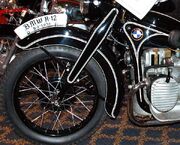
BMW's version of oil-damped telescopic fork, on a 1939 R12
Telescopic[]
A telescopic fork uses fork tubes which contain the suspension components (coil springs and damper) internally. This is the most common form of fork commercially available. It may or may not include gaiters for protection against abrasive elements on the suspension cylinders. The main advantages of the telescopic fork are that (i) it is simple in design and relatively cheap to manufacture and assemble; (ii) it is lighter than older designs using external components and linkage systems; and (iii) it has a clean and simple appearance that bikers find attractive.
Conventionally, the fork stanchions are at the top, clamped to a triple tree, (aka "yoke"), and the sliders are at the bottom, attached to the front wheel spindle.. On some modern sport bikes, this system is inverted, with "sliders" (complete with the spring/damper unit) at the top, clamped to the yoke, while the stanchions are at the bottom . This is done (i) to reduce unsprung weight by having the lighter components suspended, and (ii) to improve the strength and rigidity of the assembly by having the strong large-diameter "sliders" clamped in the yokes.[2] The inverted system is referred to as an upside-down fork, or "USD" for short. A disadvantage of this USD design is that the entire reservoir of damping oil is above the slider seal so that, if the slider seal were to leak, the oil could drain out, rendering any damping ineffective.
The first production motorcycle with hydraulically damped telescopic forks was the German BMW in 1935.[citation needed] However, undamped telescopic forks were used on bikes made by The Scott Motorcycle Company from the beginning of production in 1908,[3] and the Danish Nimbus used them from 1934 on.[citation needed]
Trailing link[]

Trailing link fork on a 1928 Indian Big Chief
A trailing link fork, which may or may not be telescopic, suspends the wheel on a link (or links) with a pivot point forward of the wheel axle. Most famously used by Indian Motocycle; it was also used by BMW for its early bikes.
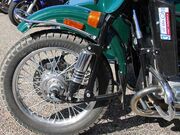
Ural's variant of the leading link fork
Leading link[]
A leading link fork, which may or may not be telescopic, suspends the wheel on a link (or links) with a pivot point aft of the wheel axle. Russian Ural motorcycles still use leading link forks on sidecar equipped motorcycles, and aftermarket leading link forks are often installed today on motorcycles when they are outfitted with sidecars. They are also very popular with trikes, improving the handling while steering or braking. The most common example of a leading link fork is that found on the Honda Super Cub.
Springer[]
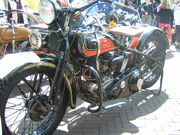
Early Harley-Davidson with springer fork
The springer fork is an early type of leading link fork. A springer fork does not have the suspension built into the fork tubes, but instead has it mounted externally, where it may be integrated into the triple tree. This style of fork may be found on antique motorcycles or choppers, and is available today on Harley-Davidson's Softail Springer.
While it may have an exposed spring near the triple clamp, a springer fork is distinguishable from a girder fork by its two parallel sets of legs. The rear is firmly fixed to the bottom triple clamp (usually brazed or welded). A short leading link holds the wheel and the forward leg which actuates the springs (usually mounted on the triple clamp).
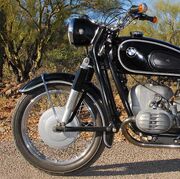
Earles fork on a 1968 BMW R60/2
Earles[]
The telescopic Earles fork was a variety of leading link fork where the pivot point was aft of the rear of the front wheel ─ this was the basis of the Earles' patent.[4] Designed by Englishman Ernest Earles, this triangulated fork actually caused the front end of a motorcycle to rise when braking hard — the reverse of the action of a telescopic fork. It was designed to accommodate sidecars, and from 1955 to 1969, BMW used the fork even though most of its motorcycles were sold as solo bikes.
Girder[]

1934 Cotton with girder fork
One of the earliest types of motorcycle front suspension, the girder fork consists of a pair of uprights attached to the triple clamp by linkages with a spring usually between the top and bottom triple clamps. The design reached its peak in the "Girdraulics" used on the Vincent motorcycle. Girdraulic forks featured forged alloy blades for extra strength and hydraulic damping.[5]
While it may have an exposed spring near the triple clamp, a girder fork is distinguishable from a springer fork by the wheel being fixed firmly to the (usually a long diamond shape) upright. The pivot points are short links mounted to the top and bottom triple clamps. The spring is (usually) mounted to the girder and compressed against the upper triple clamp.
Saxon-Motodd (Telelever)[]
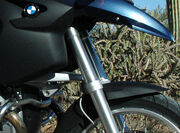
BMW Telelever fork on an R1200GS
The Saxon-Motodd (marketed as Telelever by BMW) has an additional swingarm that mounts to the frame and supports the spring. This causes the trail and castor angle (rake) to increase during braking instead of decreasing as with traditional telescopic forks.[6] In the 21st century, BMW's boxer twins are equipped with Telelever forks.
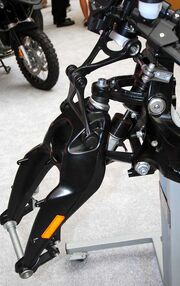
Duolever front fork
Hossack/Fior (Duolever)[]
The Hossack/Fior (marketed as Duolever by BMW) separates completely the suspension from steering forces. It was developed by Norman Hossack though used by Claude Fior and John Britten on racebikes. Hossack himself described the system as a 'steered upright'. In 2004 BMW announced the K1200S with a new front suspension that appears to be based upon the design. As of 2006, the Duolever is on the K1200S, K1200R, and K1200GT.
Coaxial steering front suspension[]
Developed by MotoCzysz for their C1 and awarded United States Patent 7111700 on September 26, 2006. It is a fork with "coaxial steering and suspension components, and having telescopic forks. Swing weight of the forks is dramatically reduced by removing their suspension components to the central location, coaxially within the steering tube. Ride height can be adjusted without loosening the forks in the triple clamps. A shock tube disposed substantially coaxially within the steering tube wherein the shock tube includes a passage therethrough substantially coaxial with the steering axis; an upper triple clamp and a lower triple clamp coupled to the shock tube; a pair of sliding-tube forks each having an upper fork tube coupled to the upper triple clamp and to the lower triple clamp, and a lower fork tube; a coil-over shock disposed within the shock tube; a front wheel rotatably coupled to the lower fork tubes; a pair of bearings rotatably coupling the shock tube to the steering tube; and a top bolt coupling the shock tube to the upper triple clamp and having a passage therethrough substantially coaxial with the steering axis; wherein the coil-over shock includes a setting adjustment mechanism which is accessible via the passages through the top bolt and the shock tube."[7]
This particular fork, as implemented on the MotoCzysz C1, also has adjustable trail, from 89 mm to 101 mm.[8]
Non-forks[]
- Main article: Hub-center steering
There have been several attempts to implement front steering and suspension without using anything that could be described as a "fork". Examples include hub-center steering, used as early as 1920 on the Ner-a-Car,[9] and implemented in the 1990s on the Bimota Tesi[10] and the Yamaha GTS1000[11]
A single-sided girder "fork" was used by the German firm Imme[12][13] between 1949 and 1951.[13]
Fork tube[]
| This section does not cite any references or sources. Please help improve this article by adding citations to reliable sources. Unverifiable material may be challenged and removed. (July 2009) |
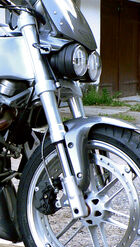
Telescopic upside down (USD) fork with stanchions at the bottom. The right fork tube can be seen held by the upper and lower triple clamp of the triple tree.
Generally employed in pairs, fork tubes (or "stanchions") link a motorcycle's front wheel to its frame. They typically house the front suspension and on telescopic fork systems compress and extend to adjust for inconsistencies in the road.
Inside most tubes are springs, fork oil, and air, creating a shock absorber. Some forks allow pressurized air to be added through a valve in the top of the fork to stiffen the suspension. Another method employs a screw to compress fork spring to increase or decrease spring pre-load.
Some forks also allow damping through variably sized orifices controlling the flow of fork oil. The larger the orifice, the more free the flow and the less damped the fork. A selector atop the fork engages the desired hole size and corresponding damping rate.
Cartridge forks provide regressive damping. Self-contained cartridges within the forks contain spring-covered orificies regulating fork oil flow. The springs resist low forces and thus provide high damping rates. Higher forces compress the springs, allowing more oil flow and less damping. Thus the fork is stiffer when responding to small bumps but will soften as larger ones are encountered.
Triple tree[]

The upper triple clamp joins the top of the fork tubes and the handlebar to the frame of a Honda 919
A triple tree ("triple clamp" (US) or "yoke" (UK)) attaches the fork tubes to the frame. Most bikes have upper and lower triple trees, providing two solid points for connecting the forks to the frame.
See also[]
- Bicycle and motorcycle dynamics
- Bicycle and motorcycle geometry
- Bicycle fork
- Hub-center steering
- Suspension (motorcycle)
References[]
- ↑ Foale, Tony. "TO DIVE OR ....". Retrieved on 2006-12-08.
- ↑ Wilson, H. The Ultimate Motorcycle Book p. 181 Dorling-Kindersley Ltd. 1993 ISBN 0 7513 0043 8
- ↑ Wilson, H. The Encyclopedia of the Motorcycle p. 166 Dorling-Kindersley Ltd. 1995 ISBN 0 7513 0206 6
- ↑ GB patent 693646, Earles, Ernest, "Motor cycle front wheel forks", published 1953-07-01
- ↑ Robert Smith (May/June 2011). "A Brief History of Girder Forks". Motorcycle Classics. Retrieved on 2011-05-20.
- ↑ Cossalter, V.. "BMW Telelever and telescopic forks: which is better ?". Retrieved on 2006-12-08.
- ↑ "Coaxial steering and suspension for motorcycle". Retrieved on 2006-12-14.
- ↑ "MotoCzysz" (2006). Retrieved on 2006-12-14.
- ↑ Willoughby, Vic [1975] (Third impression 1977). "Ner-a-Car", Classic Motorcycles. Hamlyn, 30–32. ISBN 0600318702.
- ↑ Foale, Tony. "STEER FOR THE FUTURE". Retrieved on 2006-12-09.
- ↑ McClellan, Don. "The Bike, Yamaha USA". Archived from the original on 2007-05-28. Retrieved on 2006-12-09.
- ↑ Wilson, Hugo (1995). "The A-Z of Motorcycles", The Encyclopedia of the Motorcycle (in UK English). London: Dorling Kindersley, 100. ISBN 0 7513 0206 6.
- ↑ 13.0 13.1 Wilson, Hugo (1995). "The Directory of Motorcycles", The Encyclopedia of the Motorcycle (in UK English). London: Dorling Kindersley, 241. ISBN 0 7513 0206 6.
| ||||||||||||||||||||||||||||||||||||||||||||
| This page uses some content from Wikipedia. The original article was at Motorcycle fork. The list of authors can be seen in the page history. As with Tractor & Construction Plant Wiki, the text of Wikipedia is available under the Creative Commons by Attribution License and/or GNU Free Documentation License. Please check page history for when the original article was copied to Wikia |
